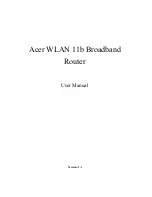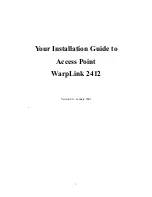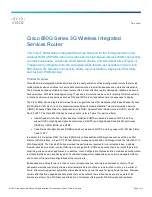
44
LAN configuration
DHCP relay
Dynamic Host Configuration Protocol (DHCP) can dynamically allocate IP addresses and other
configuration information to network clients that broadcast a request. To receive broadcast
requests, a DHCP server would normally have to be in the same broadcast domain (VLAN) as
the clients. However, when the router's DHCP relay feature is enabled, the received client
requests can be forwarded directly by the router to a specified DHCP server on another
broadcast domain (VLAN). Responses from the DHCP server are returned to the router, which
then broadcasts them back to clients.
Spanning Tree
The Spanning Tree Protocol (STP) can be used to detect and disable network loops, and to
provide backup links between switches and routers. Enabling STP allows the router to interact
with other STP-compliant switches and routers in the network to ensure that only one route exists
between any two stations on the network, and provide backup links which automatically take
over when a primary link goes down. The STP versions supported by this router include STP
(IEEE 802.1D) and Rapid STP (IEEE 802.1w).
•
Spanning Tree Protocol: STP uses a distributed algorithm to select a switch or router that
serves as the root of the spanning tree network. It selects a root port on each device (except
for the root device) that incurs the lowest path cost when forwarding a packet from that
device to the root device. Then it selects a designated device from each LAN that incurs the
lowest path cost when forwarding a packet from that LAN to the root device. All ports
connected to designated devices are assigned as designated ports. After determining the
lowest cost spanning tree, it enables all root ports and designated ports, and disables all
other ports. Network packets are therefore only forwarded between root ports and
designated ports, eliminating any possible network loops.
Once a stable network topology has been established, all devices listen for Hello BPDUs
(Bridge Protocol Data Units) transmitted from the root device (Root Bridge). If a device does
not get a Hello BPDU after a predefined interval (Maximum Age), the device assumes that
the link to the Root Bridge is down. This device will then initiate negotiations with other
devices to reconfigure the network to reestablish a valid network topology.
•
Rapid Spanning Tree Protocol: RSTP is designed as a general replacement for the slower,
legacy STP. RSTP achieves much faster reconfiguration (around 1 to 3 seconds, compared
to 30 seconds or more for STP) by reducing the number of state changes before active ports
start learning, predefining an alternate route that can be used when a node or port fails,
and retaining the forwarding database for ports insensitive to changes in the tree structure
when reconfiguration occurs.
Note
The router includes some fixed (not configurable) STP parameters, including the Hello Time (set
to 2 seconds) and Forward Delay (set to 4 seconds).
Summary of Contents for PS110
Page 6: ...6 ...
Page 10: ...10 Deploying the HP PS110 ...
Page 32: ...32 Managing the HP PS110 system ...
Page 48: ...48 LAN configuration ...
Page 76: ...76 VPN configuration ...
Page 84: ...84 Routing configuration ...
Page 94: ...94 Firewall configuration ...
Page 126: ...126 Tools ...
Page 130: ...130 ...
















































